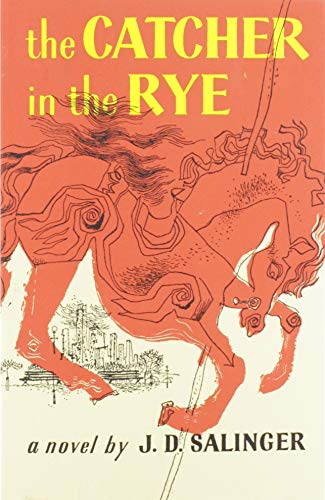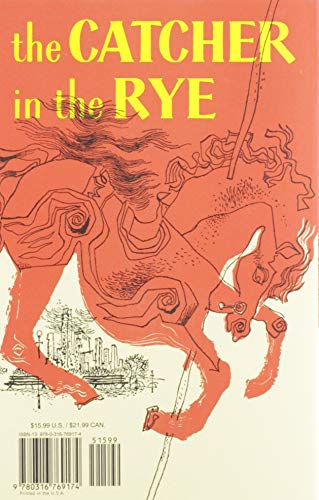The Catcher in the Rye is like a teenager’s rollercoaster ride of emotions. Buckle up, because this review will take you through Holden Caulfield’s world of angst, isolation, and dreams of saving the world one innocent kid at a time. Oh, and beware of those ducks!
In a nutshell
The Catcher in the Rye by J.D. Salinger is a classic coming-of-age novel. The book follows Holden Caulfield, a disillusioned teenager wandering through New York City. It’s packed with themes of alienation, identity, and the preservation of innocence. The genre is literary fiction, and Salinger’s raw writing style makes this a relatable and compelling read. Just imagine a teenager who’s both wise beyond his years and hilariously clueless at the same time. Enjoy the ride, but don’t expect a clear destination!
Holden Caulfield: A Portrait of Teenage Angst
Meet Holden Caulfield, the poster child for teenage angst and rebellion. He’s got a sharp tongue, a cynical outlook, and a knack for getting kicked out of prep schools. I remember when I was sixteen, I thought Holden was my spirit animal. But let me tell you, this guy takes brooding to a whole new level.
Holden is not your average protagonist. He’s a master at complaining and finding the worst in people, but that’s what makes him real. J.D. Salinger did an incredible job of making you feel like you’re walking in Holden’s worn-out shoes. One minute, he’s moaning about ‘phonies,’ and the next, he’s dreaming of being the ‘catcher in the rye,’ saving children from losing their innocence. It’s like he has this tough exterior but a gooey, soft center.
Now, if you’re looking for character development, Holden does have moments where he seems to be on the verge of an epiphany. But don’t hold your breath for a 180-degree change. He’s the kind of guy who takes two steps forward and one step back. Remember that scene where he almost connects with his younger sister, Phoebe? It’s like watching someone try to hug a cactus. Painful but heartfelt.
Holden’s journey is like a slow burn, frustrating yet fascinating. You root for him, even when he’s being a complete bonehead. But hey, aren’t we all a little like Holden at times?
So, if you’re into characters who are messily human, this book’s got you covered.
Next up, we’ll dive into the deep themes of alienation and identity. Get ready for some heavy stuff!
Themes of Alienation and Identity in The Catcher in the Rye
Holden Caulfield, the hero of The Catcher in the Rye, feels like he’s on Pluto while everyone else is on Earth. Talk about a space case, right? This guy can’t connect with anyone, not even his little sister Phoebe, who probably thinks he’s from the alien world of ‘brooding adolescents.’
Holden’s favorite sport? Alienation. He’s an all-star. Whether it’s at Pencey Prep or New York City, he’s always in the stands, never in the game. He sees everyone as a ‘phony,’ and it’s his go-to insult. However, it’s like calling every sandwich ‘gross’—at some point, you realize maybe it’s you, not the sandwich.
Identity? Oh boy, Holden is like a chameleon in a blender. One minute, he’s the suave adult ordering a drink; the next, he’s a kid wishing he could be the ‘catcher in the rye,’ saving children from falling off a cliff. It’s his way of saying he wants to protect innocence, even if he’s lost his own. I tried that once with my nephew at the playground. Let’s say it didn’t go quite as heroically.
While Holden’s lost in his identity crisis, he’s also an ace at fencing. Not the sport, but creating barriers around himself. His mental fortress is sturdy, but he’s got cracks. He becomes obsessed with protecting his self-image, yet he’s terrified of growing up and facing the phoniness he sees in adults. It’s a wonder he doesn’t split into two entirely!
In the next part, we’ll unravel the symbols and motifs that make Holden’s world spin. Trust me, you’ll want to stick around for this wild ride.
Symbolism and Motifs in ‘The Catcher in the Rye’
Holden Caulfield, our charmingly grumpy protagonist, is obsessed with the idea of protecting the innocent. One of the most powerful symbols in the book is the duck pond in Central Park. Holden keeps asking where the ducks go in the winter, symbolizing his own fear of change and the unknown. I remember once I kept asking my friends if they thought Martians would be able to hide among us—same vibes from Holden!
Another standout symbol is the Museum of Natural History. Holden loves the museum because nothing ever changes there. He can always count on the exhibits being the same, which provides him with a sense of stability in an otherwise chaotic world. It’s like how I wish pizza joints would keep their menu the same; you need some consistency in life!
Ah, the red hunting hat. This quirky accessory is more than just a fashion statement. It represents Holden’s uniqueness and his desire to stand out while also serving as a kind of security blanket. He puts it on whenever he feels vulnerable, like some sort of superhero cape. I should get myself one of those for my next awkward social event!
Finally, we have the title’s namesake—the catcher in the rye. Holden dreams of standing in a rye field, catching kids before they fall off a cliff, symbolizing his desire to save children from losing their innocence. This motif is both heartbreaking and endearing, showing Holden’s deep, albeit misguided, concern for others.
Stay tuned as we untangle the web of Holden’s thought process in the upcoming section on Writing style and narration, where things get as twisty as my aunt’s yarn collection!
Writing Style and Narration in The Catcher in the Rye
J.D. Salinger’s Writing style in The Catcher in the Rye is like a rollercoaster ride you didn’t know you wanted. It’s first-person narration, straight from the mouth of Holden Caulfield, an angsty teen who can’t seem to catch a break. He writes like he’s talking to you, which makes you feel like a confidant—his diary with ears!
Now, Holden’s narration is packed with slang and curse words. It’s kinda like your super-cool friend who tells it as it is. This makes the book feel raw and real. But, fair warning, it might also make you wanna wash Holden’s mouth out with soap. His voice is so authentic, it’s almost like he’s crashing on your couch and complaining about life. Salinger was a genius with this, making Holden’s voice unforgettable and relatable.
The sentence structure is simple, short, and punchy. Holden’s thoughts are scattered, which makes sense because the poor guy is all over the place emotionally. This fractured style can be jarring, but it also offers an unfiltered dive into Holden’s chaotic mind. He’s like that friend who constantly says, ‘and another thing…’
There’s a lot of repetition, which can be a bit annoying but also serves to emphasize Holden’s obsessions and frustrations. It’s a love-it-or-hate-it deal. It makes you wanna give him a hug and tell him it’s gonna be okay.
So, do I recommend The Catcher in the Rye? Absolutely, but it’s not everyone’s cup of tea. If you enjoy raw, emotional storytelling and don’t mind a bit of teenage angst, grab a copy and get ready for a wild ride!
Conclusion
‘The Catcher in the Rye’ by J.D. Salinger is like that one friend who is both hilarious and depressing. Holden Caulfield, our hero, wins hearts with his sarcasm and dreams of catching kids in rye fields. But remember, he hates phonies and is lost himself. The themes of alienation, identity, and preserving innocence are everywhere, from ducks in ponds to his famous red hat. Sure, Holden can be a bit whiny and repetitive, but hey, which teen isn’t? If you’re up for an emotional, relatable read with some laughs along the way, grab this book. And that’s my review!



